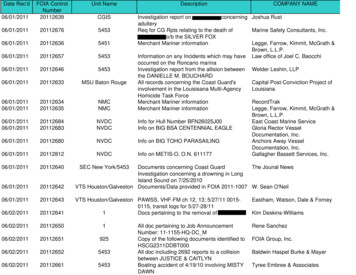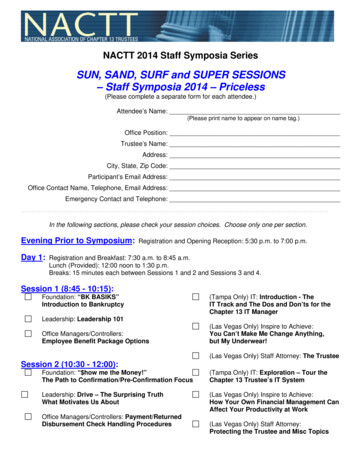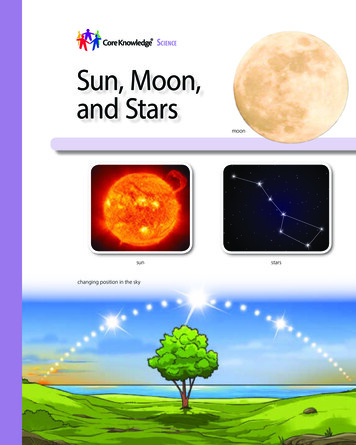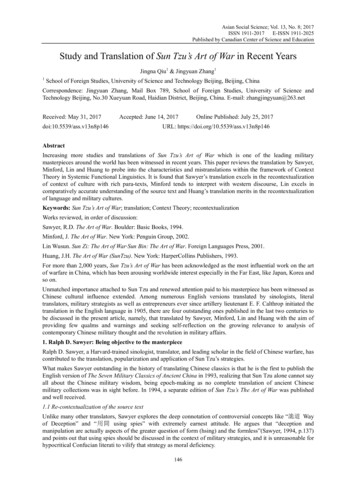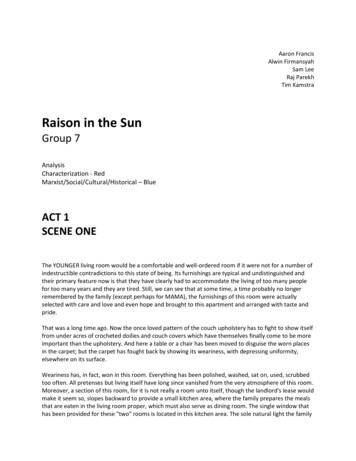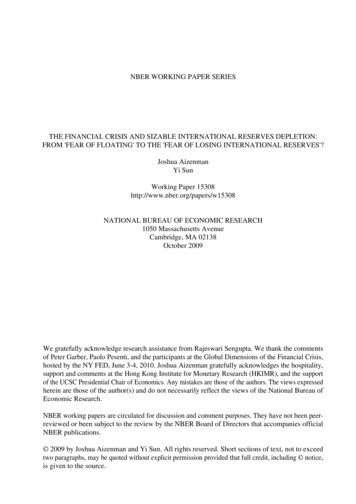
Transcription
NBER WORKING PAPER SERIESTHE FINANCIAL CRISIS AND SIZABLE INTERNATIONAL RESERVES DEPLETION:FROM 'FEAR OF FLOATING' TO THE 'FEAR OF LOSING INTERNATIONAL RESERVES'?Joshua AizenmanYi SunWorking Paper 15308http://www.nber.org/papers/w15308NATIONAL BUREAU OF ECONOMIC RESEARCH1050 Massachusetts AvenueCambridge, MA 02138October 2009We gratefully acknowledge research assistance from Rajeswari Sengupta. We thank the commentsof Peter Garber, Paolo Pesenti, and the participants at the Global Dimensions of the Financial Crisis,hosted by the NY FED, June 3-4, 2010. Joshua Aizenman gratefully acknowledges the hospitality,support and comments at the Hong Kong Institute for Monetary Research (HKIMR), and the supportof the UCSC Presidential Chair of Economics. Any mistakes are those of the authors. The views expressedherein are those of the author(s) and do not necessarily reflect the views of the National Bureau ofEconomic Research.NBER working papers are circulated for discussion and comment purposes. They have not been peerreviewed or been subject to the review by the NBER Board of Directors that accompanies officialNBER publications. 2009 by Joshua Aizenman and Yi Sun. All rights reserved. Short sections of text, not to exceedtwo paragraphs, may be quoted without explicit permission provided that full credit, including notice,is given to the source.
The financial crisis and sizable international reserves depletion: From 'fear of floating' to the'fear of losing international reserves'?Joshua Aizenman and Yi SunNBER Working Paper No. 15308October 2009, Revised January 2011JEL No. F15,F31,F32,F42ABSTRACTIn this paper we study the degree to which Emerging Markets (EMs) adjusted to the global liquiditycrisis by drawing down their international reserves (IR). Overall, we find a mixed and complex picture.Intriguingly, only about half of the EMs depleted their IR as part of the adjustment mechanism. Togain further insight, we compare pre-crisis demand for IR of countries that experienced sizable IRdepletion, to that of countries that did not, and find different patterns between the two groups. Traderelated factors (such as trade openness, primary goods export ratio, especially large oil export) seemto play a significant role in accounting for the pre-crisis IR/GDP level of countries that experienceda sizable IR depletion during the first phase of crisis. Our findings suggest that countries that internalizedtheir large exposure to trade shocks before the crisis, used their IR as a buffer stock in the first phaseof the crisis. Their reserves losses followed an inverted logistical curve. After a rapid initial depletionof reverses, within seven months they reached a markedly declining rate of IR depletion, losing notmore than one-third of their pre crisis IR. On the contrary, in case of countries that refrained froma sizable IR depletion during the first phase of crisis, financial factors seem more important than tradefactors in explaining the initial IR/GDP level. Our results indicate that the adjustment of EMs wasconstrained more by their fear of losing IR than by their fear of floating.Joshua AizenmanDepartment of Economics; E21156 High St.University of California, Santa CruzSanta Cruz, CA 95064and NBERjaizen@ucsc.eduYi SunEconomics E2UCSCSanta Cruz, CA, 95064ysun@ucsc.edu
The 2008-9 global financial crisis imposes daunting challenges to emerging markets(EMs). Earlier hopes of ‘decoupling,’ that would have allowed EMs to be spared the brunt ofadverse adjustments have not materialized. The “flight to quality,” deleveraging and the rapidreduction of international trade began affecting EMs from mid 2008, putting to test theiradjustment capabilities. During earlier crises episodes, EMs were forced to adjust mostly viarapid depreciation. However, the sizable hoarding of international reserves (IR) during the late1990s and early 2000s, provided these countries with a relatively richer menu of choices. In thispaper we study the degree to which earlier hoarding of IR “paid off,” by allowing EMs to buffertheir adjustment by drawing down IR stocks.To recall, investigating the patterns of exchange rates, interest rates and IR during1970-1999, Calvo and Reinhart (2002) inferred the prevalence of the “fear of floating”. Countriesclaiming that they allow their exchange rates to float, mostly do not. Instead, the authoritiesfrequently attempt to stabilize the exchange rate through direct intervention in foreign exchangemarket and open market operations. The fear of floating may also provide an interpretation for themassive hoarding of IR during the last ten years by EMs and other developing countries.Alternative explanations of IR hoarding however include the precautionary and/or mercantilistmotives [Aizenman and Lee (2007, 2008)], and the Bretton Woods II interpretation [Dooley,Garber and (2003)]. This study looks at the factors accounting for the depletion of IR during the2008-9 crisis, investigate the dynamics of drawing down of IR by EMs, and verify the degree towhich the fear of floating dominated the use of IR during the crisis. We explore the adjustment of21 EMs during the window of the crisis and reveal a mixed and complex picture. Regressionanalysis shows that EMs with large primary commodity exports, especially oil exports,experienced large IR losses during the 2008-9 global crisis. Countries with a medium level offinancial openness and a large short term external debt to GDP ratio also on average lost more oftheir initial IR holdings. Most of the countries that suffered large IR losses, started depleting theirIR during the second half of 2008. Quite intriguingly, only about half of the EMs relied onsignificant depletion of their IR as part of their adjustment mechanism.1
We proceed by dividing the sample of EMs into two groups: countries that experiencedsizable IR losses and countries that had either not lost IR or quickly recovered from their IR losses.The first group is defined as countries that lost at least 10 per cent of their IR during the period ofJuly 2008 - February 2009 relative to their highest IR level. Among 21 EMs, 9 countries belongto the first group. To gain further insight, we compare the pre-crisis demand for IR/GDP ofcountries that experienced sizable depletion of their IR, to that of countries that did not, and finddifferential patterns across the two groups. Trade related factors (such as trade openness, and theprimary goods export, especially large oil export) seem to be more significant in accounting for thepre-crisis IR/GDP levels of countries that experienced a sizable depletion of IR in the first phase ofthe crisis. These findings suggest that countries that internalized their large exposure to tradeshocks before the crisis used their IR as a buffer stock in the first phase of crisis. The IR losses ofthese countries followed an inverted logistical curve. After a rapid initial depletion of IR, thesecountries reached within 7 months a markedly declining rate of IR depletion, and lost not morethan one-third of their pre crisis IR.In contrast, in case of countries that refrained from a sizable depletion of IR during the firstcrisis phase, financial factors seem more important than trade factors in explaining the initial levelof IR/GDP. These countries refrained from using IR altogether and achieved external adjustmentthrough large depreciations of their currencies. The patterns of using IR by the first group ofcountries, and refraining from using IR by the second group, are consistent with the ‘fear of losingreserves.’ Such a fear may reflect a country’s concern that dwindling IR may signal greatervulnerability to run on its currency, thereby triggering such a run on its remaining reserves. Thisfear may be related to a country’s apprehension that, as the duration of the crisis in unknown,depleting IR quickly may be suboptimal.Our results suggest that the adjustment of EMs during the on-going global liquidity crisishas been constrained more by their fear of losing IR than by their fear of floating. Countries’choice of currency depreciation instead of reserve depletion also suggests that some may opt torevisit the gains from financial globalization. Earlier research suggests that EMs that increased2
their financial integration during the 1990s and mid 2000s, accumulated IRs due to precautionarymotives, to obtain self insurance against sudden stops, capital flights, and deleveraging crises [SeeCalvo (1998) and Obstfeld, Shambaugh and Taylor (2010)]. Yet, the 2008-9 global crisissuggests that the levels of IR required in order for this self-insurance to work may be comparableto that of a country’s gross external financial exposure [see Park (2009) analyzing Korea’schallenges during the crisis]. In these circumstances, prudential supervision that would tighten thelink between short-term external borrowing and hoarding IR would mitigate the excessiveexposure to deleveraging risks induced by short-term external borrowing.In Section 1, we analyze the impact of recent financial crisis on IR holdings in EMs.After documenting that about half of the EMs experienced a large decline of their IR, we look forfactors explaining the depletion of IR. In Section 2, we explain the factors determining the speedof drawing down IR. Finally we conclude in Section 3.1.IR changes in all emerging marketsOur sample consists of countries listed in the FTSE and MSCI emerging market list.1 Wehave not included Singapore and Hong-Kong because of their special economic structure,specializing in entrepôt services.2 Figure 1 presents IR holdings since January 2008 of the 21EMs included in our sample. In Figure 1a, IR are normalized by a country’s GDP. In Figure 1b,IR are measured relative to the highest IR level since January 2008. From Figure 1, we can see1As of April 2009, MSCI Barra classified the following 22 countries as emerging markets: Brazil, Chile,China, Colombia, Czech Republic, Egypt, Hungary, India, Indonesia, Israel, Malaysia, Mexico, Morocco,Peru, Philippines, Poland, Russia, South Africa, South Korea, Taiwan, Thailand, Turkey ty/index.jsp]. The FTSE emerging markets classificationis similar to that of MSCI, adding Argentina, subtracting Israel [seehttp://www.ftse.com/Indices/FTSE Emerging Markets/index.jsp ].The list tracked by The Economist is the same as the MSCI, except with Hong Kong, Singapore andSaudi Arabia included (MSCI classifies the first two as Developed Markets).2Considering the dramatic effect of the IMF’s aid on Hungary’s reserves changes, we excluded it fromour sample. Following the IMF’s announced its loan to Hungary in November 2008, Hungary’sinternational reserves have increased nearly by half in the next two months. Due to data availability, wedid not include Morocco and Pakistan.3
that more than half of the EMs in our sample reduced their IR holdings during the 2008-9 crisis.Most countries experiencing large IR losses began depleting their IR during the second half of2008. We next look into the factors that may have caused a country to deplete its IR holdingsduring the global financial crisis.1.1 Data and explanatory variablesIn our analysis, we use several measures of IR changes. Most EMs began exhibiting largeIR losses during second half of 2008, and regained most of their losses by first quarter of 2009.Hence, we use July 2008 to February 2009 as the time window for our case study. We measureIR changes in two ways: IR changes relative to a country’s GDP; and IR changes relative to acountry’s initial IR level in our sample period.3We include both trade related factors and financial market related factors as potentialexplanatory variables accounting for changes in IR patterns. The first variable we consider istrade openness (henceforth labeled as topen), defined as the sum of imports and exports overGDP in the year before the crisis. The second trade variable is a country’s oil export share,(oilex/gdp). It is measured as a country’s net oil export level in 2005 (by 1000 barrels per day)divided by its GDP. The third variable is the primary products export ratio (prim2export), definedas the value of fuel and non-fuel primary products export, divided by total exports.4We alsoconsider historic export volatility (xvolatile) as an explanatory variable. It is measured as thestandard deviation of monthly export growth rates (year to year) of the previous year. We expectcountries with greater trade dependence will be impacted more following a negative global shockthat leads to rapid decline in international trade. Thus, relatively higher trade openness, largernet oil exports, larger primary product export ratio, and higher export volatility to experience alarger IR loss when faced with a negative global shock. The larger IR losses may reflectdwindling revenue from export (reflecting lower demand for export, tighter trade credit,3We have tried other measures in our analysis, e.g. IR changes divided by the highest IR level during oursample period. However the results were very similar to the results of the previous two measures,therefore we did not report those results here.4The data of primary products is collected from the United Nations Commodity Trade StatisticsDatabase. Fuel and non-fuel primary products used in our sample are defined as the products in SITC 0, 1,2, 3, 4 and 68 categories.4
deteriorating terms of trade, etc.), and possibly greater deleveraging of foreign positions in theeconomy, reflecting anticipation of lower future growth.In the category of financial market factors, the first variable we include is financialopenness. We use the Chinn-Ito capital market openness index (Kopen). The second variable ishistoric exchange rate volatility (exstdev), which is measured as the standard deviation ofmonthly exchange rate growth rate (month to month changes). The last variable in this categoryis the short term external debt relative to a country’s GDP (STdebt/gdp)5. In general, the impactof financial openness on IR losses may be ambiguous. For countries that allow larger exchangerate volatility, we expect lower IR changes during the crisis. Whereas countries with relativelylarge short term external debt may opt to lose more IR during crisis. In our empirical estimations,we have also included other control variables, such as previous year’s GDP (gdp07), per capitaGDP (gdppc) as well as some interaction terms involving these explanatory variables. Table 1presents summary statistics for the variables used in our cross section analysis.1.2 Regression resultsTables 2 and 3 present the regression results, accounting for the variation of our two IRchange measures and using different explanatory variables. Dependent variable in Table 2 is theIR change from July 2008 to Feb 2009 measured as a ratio to a country’s GDP. Dependentvariable in Table 3 is the IR change over the same period measured as a ratio to a country’s initialIR level, i.e. IR level in July 2008. The explanatory variables are measured using 2007 dataexcept for short term external debt and oil export ratio.6In Table 2, we first control for four trade factors in our regressions. Columns 2 and 3show that the primary product exports, especially oil exports, have significant impact on IRchanges. Since including the primary product export ratio gives similar results as those of the oilexport ratio, we have not reported other regressions including primary export ratios. Tradeopenness affects IR changes only when we control for the primary product exports or oil exports.5Short term debt data is based on the IMF debt statistics tables drawn from creditor and market sources.In table 2 and 3, short term debt are measured by June 2008 level. Due to data constraint, the oil exportlevel used here is taken from 2005 data.56
When we include trade openness, oil exports, and their interaction term (topenXoilex), tradeopenness is found to have negative impact on IR changes. The oil export ratio also has negativeimpact on IR, but shows up only in the interaction term (Column 4 reports this result, and alsosee figure 2.a). However, export volatility does not seem to have any significant relationship withIR changes, and so we do not report it in Table 2.Next, we include financial openness, exchange rate volatility and short term debt ratio inour regression. Financial openness has some impact on IR changes. However the relationshipbetween IR changes and financial openness is non-linear. Low and high financial openness (i.e.openness index value either close to -1 or close to 2 and 3) are related to a small IR loss, or to anincrease in IR holdings. In contrast, countries with medium financial openness (i.e. withopenness index value close to 0) tend to experience larger IR losses (see figure 2b). In column 6,we add to the selected trade-related factors, the absolute value of Chinn-Ito index, and find it tohave a significant positive association with IR changes. We also find that short term externaldebts have a negative impact on IR changes. Column 7 shows that countries with large shortterm external debts tend to have relatively large IR losses during the crisis (also see figure 2.c).Exchange rate volatility turned out to be insignificant, and thus we do not include them in thereported regressions.7In the last column we include initial IR level (labeled Ini.IR, and measured as the IR/GDPlevel in July 2008) as an explanatory variable. The significant negative sign of Ini.IR shows thatlarge IR/GDP levels during the pre-crisis period were associated with large IR/GDP declinesduring the crisis period. The higher pre-crisis IR/GDP level may have encouraged countries tospend more IR during the crisis to absorb the external shock (and countries that faced large IRlosses in process of crisis management, maybe hypothesized tocrisis).accumulate more IR after theTable 3 presents similar regressions for the case where the IR change is calculatedrelative to its initial IR level, ((IR2009.2 – IR2008.7) / IR2008.7). Overall, the results are similar. Trade7We have also tried other factors such as country size (GDP2007) and country income level (measuredas the 2007 per capita GDP). Both turned out to be insignificant, and hence we do not report them in thetable.6
openness is insignificant, but the primary product export/total export ratio, oil export/GDP ratioand the absolute value of the financial openness index – all remain significant as in Table 2. Thelast regression in Table 3 also shows that the initial levels of IR no longer have a large impact onthe relative changes in reserves level. In subsequent analysis we find that trade openness plays animportant role in deciding countries’ initial IR levels. Hence one interpretation of the differencesin results of Table 2 and Table 3 could be that trade openness affects initial IR level, and thus themagnitude of changes in IR/GDP ratio, but it does not have any direct impact on the relative IRchanges. On the other hand, primary commodity exports, oil exports and financial openness notonly affect the initial IR level, but also affect the patterns of relative IR changes.Based on results in Tables 2 and 3, we find that EMs with a large primary commodityexport, especially oil export, tend to experience relatively large IR loss during the 2008-9 globalcrisis. EMs with a medium level of financial openness and a large short term debt ratio also lost alarger share of their IR holdings. Trade openness affects a country’s initial IR level. Tradeopenness and the initial IR level together affect the magnitude of IR changes relative to GDP, butdo not have any impact on the IR changes relative to a country’s historic IR level.EMs accumulate IR for different reasons such as to protect from trade shocks, to promoteexports, etc. Thus, they may use their IRs differently as well when facing the same externalshock. Comparing pre-crisis level of IR/GDP of EMs that depleted a signifi
explanatory variables accounting for changes in IR patterns. The first variable we consider is trade openness (henceforth labeled as topen), defined as the sum of imports and exports over GDP in the year before the crisis. The second t



